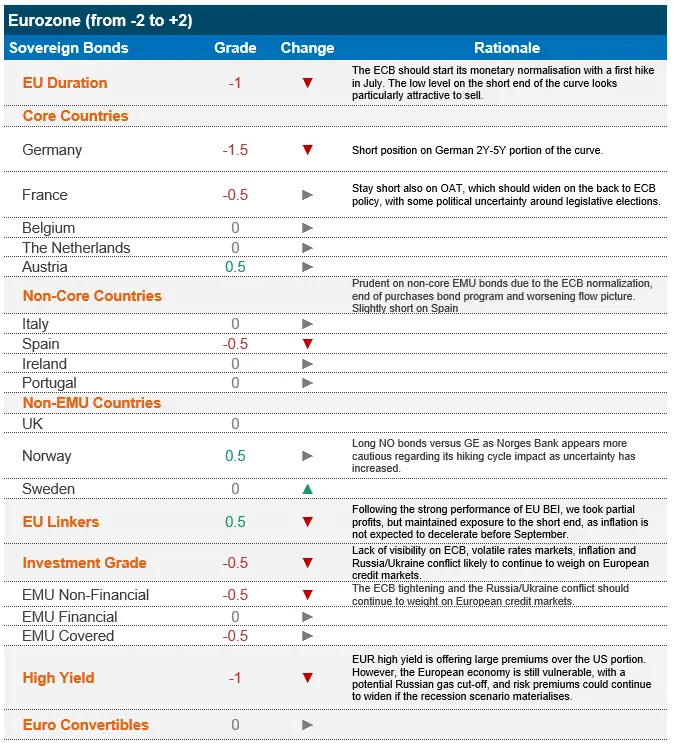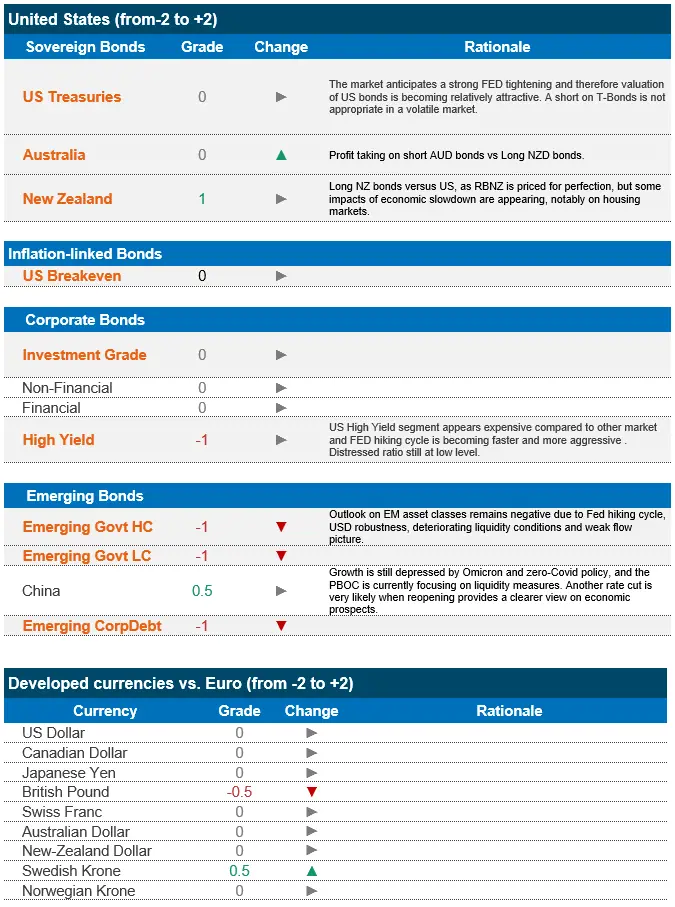The performance of the fixed income asset class was impacted by geopolitics, the rise in inflation and the generally hawkish stance of central banks. The resulting rise in rates affected all asset classes, with an uptick in volatility. Credit markets continued to suffer, as both investment grade and high yield credit markets posted negative returns both in the US and in Europe, with every sector contributing to the weak performance (including defensive sectors such as telecoms, and pharma). Emerging debt also posted negative returns in every segment (hard currency, local currency and corporates). In an environment where almost no asset class was spared (even sovereign safe havens), European peripheral sovereigns also underperformed. Not surprisingly, breakevens posted positive performances (led by Australia and Japan), as did certain commodity markets like natural gas. Within currencies, the ruble’s acute rise continued after February’s extremely sharp decline as a result of central bank activity and fiscal measures. The US dollar remains a very strong performer (reflecting the work of the central bank and the strength of its economy). Certain EM currencies also did well (MXN, IDR), while some safe havens suffered somewhat.
Fixed income markets across the board appear to be challenged by a rather difficult environment. Geopolitical risk remains omnipresent, with no end in sight in the Russia/Ukraine conflict. Adding to this issue are the ongoing and incremental sanctions that are impacting Russia and the rest of the world in macroeconomic terms. The severe Covid lockdowns in China are yet another element calling into question global growth, on top of the already existing problem of supply chain blocks. These factors are heavily contributing to the severe uptick in inflation, and in the absence of some form of resolution, we expect this situation to persist. In such a context, central banks across the globe (excluding China) are compelled to persevere in their hawkish stance. The Federal Reserve has indicated that it is willing to engineer a macroeconomic slowdown (through tightening) in order to control inflation. As a base case scenario, we expect a 50 bps rate hike at each of the next two FOMC meetings, and we will very carefully monitor the resulting impact on the US economy. The ECB has also hinted strongly at continued monetary tightening, though the central bank is facing a lack of consensus amongst members and appears to be devoid of an assertive stance, contributing to the reduced visibility on its future actions. It appears, however, that the end of its QE programme is expected in June, while a lift-off in rates is very likely in July. The eurozone economy faces greater headwinds in the form of greater proximity to the Russia/Ukraine situation and higher dependence on oil and gas from Russia.
Against this backdrop, we expect volatility to remain high and rates to trend upwards over the coming weeks. We suggest a neutral stance on US duration and an underweight on EU duration, as the ECB is under pressure to normalise more rapidly due to high inflation. Valuations on fixed income markets are certainly more compelling, though we recognise the need to wait for rate stabilisation before we turn positive on risky assets. We expect dispersion to materialise soon, as fundamentals return to the forefront (in the absence of external support) and the impact of key trends (deglobalisation, decarbonation and digitisation) starts to materialise. However, currently, in a market that is expected to continue to be negatively impacted by the external factors mentioned above, we aim to maintain our overall defensive stance while monitoring the markets very closely. We also have a cautious view on emerging markets, as the Chinese economic slowdown, Fed policy tightening and the USD weigh on the asset class. The political situation will likely deteriorate, as cost of living concerns start to severely impact economies that are more commodity-dependant and less resistant.
Strategy & Positioning
It is important to note that Candriam Global Bond and Credit strategies have no exposure to Russian sovereign debt. Russia has been excluded from our sovereign investment universe based on sustainability characteristics.


